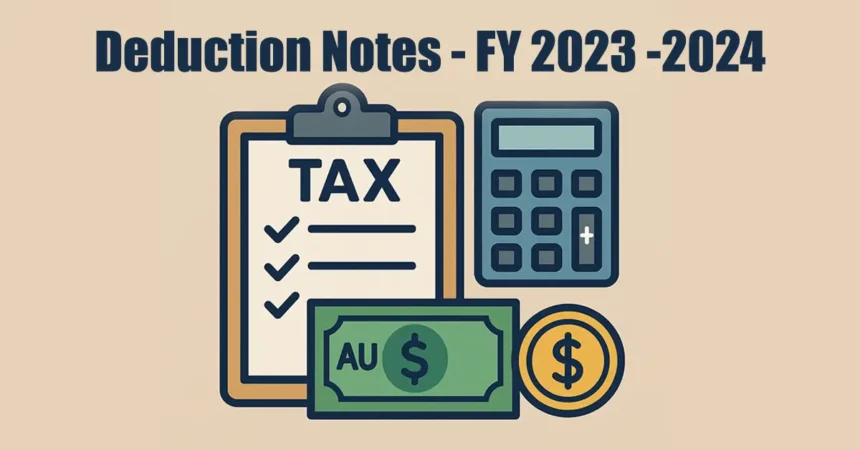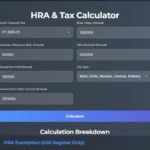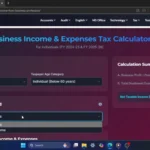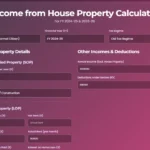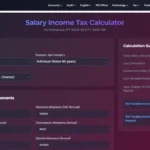D1 – Work-Related Car Expenses
Work-related car expenses are expenses you incurred as an employee for a car you owned or leased or hired under a hire-purchase agreement.
Two Methods:1
- Cents per kilometre method:
- $0.85 Per Km for FY 2023-2024.
- Can claim a maximum of up to 5000km.
- Actual Logbook method: Which includes:
- Electronic or Pre-printed logbook (must be current, generally for a 12-week continuous period and representative of your travel throughout the year).
- Evidence of your actual fuel and oil costs.
- Odometer readings (start and end of the logbook period, and start and end of the financial year).
- Other car expenses like car repairs, car registration, and car insurance, etc.
- Can claim depreciation for the motor vehicle (based on its cost and effective life).
D2 – Work-related travel expenses
Travel expenses you incur in performing your work as an employee. These can include:
- Public transport, air travel, and taxi fares.
- Bridge and road tolls, parking fees, and short-term car hire.
- Meal, accommodation, and incidental expenses you incur while away overnight for work2 (you must keep records).
- Expenses for motorcycles and vehicles with a carrying capacity of one tonne or more, or nine or more passengers, such as utility trucks and panel vans (claimed using actual costs, not cents per km).
- Actual expenses, such as petrol, repair, and maintenance costs, that you incur to travel in a car that is owned or leased by someone else.
D3 – Work-related clothing, laundry, and dry-cleaning expenses
You can claim expenses for:
- Protective clothing and footwear (e.g., steel-capped boots, high-vis vests).
- Uniforms (Compulsory Uniform – distinctive to your employer & Non-Compulsory Uniform – if registered with AusIndustry).
- Occupation-specific clothing (that clearly identifies you as belonging to a particular profession, e.g., chef’s checked pants).
- Laundering and dry-cleaning of the above three categories.
- Cost of renting, repairing, and cleaning work-related clothing.
(Note: If washing, drying, or ironing eligible work clothes by yourself, then on a reasonable basis you can claim $1 per load if the load contains only work-related clothing, or $0.50 per load if you mix work-related clothing with other laundry items. You need to keep records if your total claim for work-related expenses exceeds $300, or if your laundry claim exceeds $150).
D4 – Work-related self‑education expenses
You can claim a deduction if the self-education has a sufficient connection to your current employment and:
- The course maintained or improved a skill or specific knowledge required for your current work activities, or
- The course was leading to, or likely to lead to, increased income from your current work activities.
- You cannot claim a deduction if the study is only generally related to your employment or will enable you to get a new job.
D5 – Other work-related expenses
Other work-related expenses are expenses you incurred as an employee and have not claimed anywhere else on your tax return. For working from home expenses, you can choose between the revised fixed rate method or the actual cost method.
Working From Home Expenses (FY 2023-2024):
- Revised Fixed Rate Method:
- $0.67 per hour worked from home.
- This rate covers:
- Energy expenses (electricity and gas).
- Phone usage (mobile and/or home line).
- Internet.
- Stationery and computer consumables.
- You cannot claim separate deductions for any expenses covered by this rate.
- You can claim separate deductions for the decline in value (depreciation) of work-related equipment (e.g., computers, office furniture) and repairs or maintenance of that equipment.
- Record Keeping is crucial: You must keep a record of all actual hours worked from home for the entire income year (e.g., timesheets, rosters, a diary kept contemporaneously). Estimates are not accepted. You must also keep records for any expenses claimed separately (e.g., invoices for assets).
- Actual Cost Method (Based on Actual Expenses Incurred for working from home and other general work expenses):
- For working from home, this involves keeping detailed records of all expenses and calculating the work-related portion. This includes:
- Depreciation of Office Equipment (Laptop, Computer, Keyboard).
- Depreciation of Office Furniture (Desk, Chair).
- Work-related portion of telephone and internet expenses.
- Work-related portion of electricity and gas (based on itemised bills and an established pattern of work use).
- Work-related portion of stationery and computer consumables.
- Other general work-related expenses (not necessarily WFH related) claimable under this section if not elsewhere:
- Union fees and Subscriptions fees to trade, business, or professional associations.
- Overtime meal expenses (if you receive an overtime meal allowance reported on your income statement and meet the conditions).
- Professional seminars, courses, conferences, and workshops (if not claimed at D4).
- Reference books, technical journals, and Trade magazines.
- Safety items such as hard hats, safety glasses, sunscreens (if not claimed at D3).
- Other tools and equipment not exceeding $300.
- Note on Assets:
- If a Work Related Asset costs less than or equal to $300, then you can claim an immediate deduction for the full cost (work-related portion).
- If a Work Related Asset costs more than $300, then you add it to an Asset Register and claim depreciation (decline in value) for the work-related portion based on its effective life (as per ATO Depreciation Rates for FY 2024).
- For working from home, this involves keeping detailed records of all expenses and calculating the work-related portion. This includes:
D6 – Low-Value Pool Deduction
Low-Value Pool Deduction Means:
Claiming a deduction for the decline in value of low-cost and low-value assets that you used in the course of producing5 income.
- Low-Cost Assets: Depreciating Assets that cost less than $1,000 (work-related portion) when first acquired and used for an income-producing purpose in the year.
- Low-Value Assets: Depreciating assets that are not low-cost assets (i.e., cost $1,000 or more initially) but whose opening adjustable value (written down value) as on 1 July 2023 (using the diminishing value method) is less than $1,000.
Assets are allocated to the pool, and the pool is depreciated at set rates:
- 18.75% for the work-related portion of low-cost assets added during the year.
- 37.5% for the work-related portion of any low-value assets added during the year and for the opening balance of the pool (after adjustments).
Example 1 (updated for FY 2024 context): Emil bought a printer for $600 in 2023–24. Emil uses this printer for Personal purposes 60% and for Office purposes 40%. This is a low-cost asset.
Example 2 (updated for FY 2024 context): Emil previously claimed deductions under the diminishing value method for a laptop that he purchased for $1,500. The laptop’s opening adjustable value on 1 July 20236 was $900. This is a low-value asset.
Solution for Example 1 & 2 (Illustrative – use ATO calculator for precision)
| Calculation | Low-Cost Asset (Printer) | Low-Value Asset (Laptop) |
| Cost / Opening Value (Work Portion) | $240 ($600 × 40%) | $900 (assuming 100% work use for this example value) |
| Applicable Pool Depreciation Rate | 18.75% | 37.5% |
| Low Value Pool Deduction Allowed (Illustrative) | $45 ($240 × 18.75%) | $337.50 ($900 × 37.5%) |
D6 – Low-Value Pool Deduction (Illustrative) = $382.50 ($45 + $337.50)
Notes: If you claim a deduction for an asset under D6, then don’t claim a deduction for that asset under D1 to D5.
D7 – Interest Deductions
Expenses include:
- Bank or other financial institution account-keeping fees for accounts held for investment purposes.
- Fees for investment advice related to changes in the mix of your investments.
- The interest you paid on money you borrowed to purchase income-producing investments (e.g., shares, rental property).
D8 – Dividend Deduction
Expenses include:
- Fees for investment advice related to managing your dividend-producing investments (e.g., Portfolio Agent Fees).
- Interest paid on money borrowed to purchase shares or similar investments that produce dividends.
- Costs relating to managing your investments, such as travel directly related to attending company AGMs (conditions apply) or buying specialist investment journals or subscriptions.
D9 – Gifts or donations
- You can claim a Gift or donation of $2 or more to an approved Deductible Gift Recipient (DGR) organisation.
- Generally, you cannot claim a deduction for a gift or donation if you received something of material benefit in return (e.g., raffle tickets, event entry).
- To check an Approved organization, use the ABN Lookup website: https://abr.business.gov.au/ (and confirm its DGR status).
D10 – Cost of managing Tax Affairs
You can claim:
- Interest charged by the ATO (on late payment of tax, for example).
- Costs for preparing and lodging your Tax return and Activity statements.
- Fees paid to a recognized tax adviser for preparing and lodging your tax return (Tax Agent Fees).
- Litigation costs (including court and Administrative Appeal Tribunal fees, and other legal costs you incurred in managing your tax affairs).8
- Travel to obtain tax advice from a recognized tax adviser.
- Cost of buying tax reference material.
- Costs for dealing with the ATO about your tax affairs.
Notes: Tax Agent Fees are deductible in the year they are paid (Cash Method). So, if you paid your FY2023 tax agent fee in FY2024, you claim it in your FY2024 tax return.
D11 – Deductible amount of undeducted purchase price (UPP) of a foreign pension or annuity
- If you showed income from a foreign pension or annuity under Label 20 (Foreign source income), you may be eligible to deduct the UPP of that foreign pension or annuity under Label D11.
- Undeducted purchase price (UPP) is the amount you contributed towards the purchase price of your foreign pension or annuity for which you did not claim a tax deduction in Australia.
D12 – Personal Superannuation Contributions
Claiming Deduction under D12 Personal Superannuation Contribution for FY 2023-2024:
There are limits on how much deduction you can claim. You must also have provided a valid ‘Notice of intent to claim’ to your super fund and received an acknowledgement.
Example (Illustrative for FY 2023-2024):
(WordPress Note: Use a Table Block here for best formatting)
Scenario
| Particular | Amount |
| FY | 2023-24 |
| Your Salary Income | $80,000 pa |
| Compulsory Employer Contribution (Super Guarantee e.g., 11% for FY 2023-24) | $8,800 pa |
| Salary Sacrificed to Superannuation Before Tax ($50 x 52 Weeks) | $2,600 pa |
| Total Concessional contributions received by fund (Employer SG + Salary Sacrifice) | $11,400 pa |
| General Concessional Contributions Cap for FY 2023-24 | $27,500 pa |
| Remaining Cap before considering carry-forward amounts ($27,500 – $11,400) | $16,100 pa |
| Additional Personal (after-tax) Contribution made, intending to claim as a deduction (PSC) | $11,500 pa |
| Assume Total Super Balance at 30 June 2023 was under $500,000 and unused cap amounts are available if needed. |
Deduction Calculation
| Particular | Amount |
| Remaining Concessional Cap for FY 2023-24 (a) | $16,100 pa |
| Actual Personal Superannuation Contribution made for which deduction is intended (b) | $11,500 pa |
| Whichever is Lower (a vs b) can be claimed as a deduction under D12 (subject to all rules) | $11,500 pa |
(Note: Eligibility to use carry-forward unused concessional contributions depends on your Total Super Balance on 30 June of the previous year being less than $500,000 and having unused cap amounts from the previous 5 financial years.)
D13 – Deduction for project pool
You can claim a deduction for:
- Certain capital expenditure directly connected to a project that operates for a finite period (e.g., a resources project).
- This deduction of capital expenditure is allowed over the life of the project (‘project life’).
- This applies to specific types of capital expenditures that do not form part of the cost of a depreciating asset.
To deduct capital expenditure, it must be one of seven specific types of capital expenditure incurred for a project, such as:
- To create or upgrade community infrastructure for a community associated with the project.
- To obtain information associated with the project.
- For site preparation costs for depreciating assets (with some exceptions).
- For feasibility studies for the project.
- For environmental assessments for the project.
- For ornamental trees and shrubs (if for landcare operations for the project).
- Seeking to obtain a right to intellectual property (if for the project).
D14 – Forestry managed investment scheme deduction
- Forestry means planting, managing, and caring for forests.
- A Forestry Managed Investment Scheme (FMIS) is a scheme that encourages the expansion of forestry in Australia through the establishment and tending of new plantations for felling.
There are two different types of investors in FMIS:
- Initial participants – Can claim a deduction under D14.
- Following conditions must be satisfied to be an initial participant:
- The investment in the FMIS scheme must be a qualified FMIS scheme.
- The FMIS interest was obtained from the forestry manager of the scheme (not on a secondary market).
- Payment for the FMIS interest results in the establishment of trees.
- Following conditions must be satisfied to be an initial participant:
- Subsequent participants – Cannot claim a deduction under D14.
- Subsequent participants are those who acquire their interest in an FMIS scheme through secondary market trading.
D15 – Other deductions
(Deductions not claimable under D1 to D14 or elsewhere on the Tax return for FY 2023-2024)
Following items may be allowed to be claimed under D15 (check specific conditions):
- Election expenses for local, territory, state, or federal candidates (up to certain limits).
- Income protection, sickness, and accident insurance premiums (where the policy replaces income).
- Foreign exchange losses (if related to assessable income or a deductible expense, and certain conditions are met).
- Debt deductions incurred in earning assessable income (if not claimed elsewhere, e.g., specific investment interest).
- Debt deductions incurred in earning certain foreign non-assessable non-exempt income that are not disallowed under the thin capitalisation rules.11
- Deduction for the Net Personal Services Income (PSI) loss of a personal services entity that related to your client’s personal services income (if rules are met).
- Interest incurred on money borrowed to invest under an eligible infrastructure borrowings scheme.
- Self-education expenses you incurred in doing a course to satisfy the study requirements of a taxable scholarship (if not claimed at D4).
Following items are generally NOT allowed to be claimed under D15 (they usually belong elsewhere or are not deductible):
- Expenses relating to their work as an employee (these are typically claimed under D1-D5).
- Expenses relating to income from carrying on a business as a sole trader (these are business deductions, not typically at D15 for an individual ITR unless specific PSI rules apply).
- Expenses relating to investment planning and advice involving shares, unit trusts, and interest-bearing deposits (parts may be claimable under D7 or D8).
- Losses from the disposal of shares or real property that are capital in nature (these are handled under Capital Gains Tax provisions).
Remember to always refer to the latest ATO guidance or consult with a registered tax agent for advice specific to your circumstances. This information is for general guidance only.

